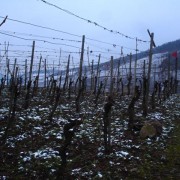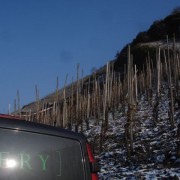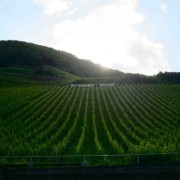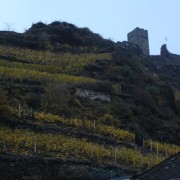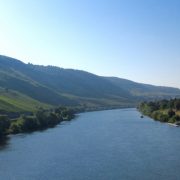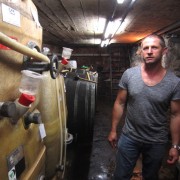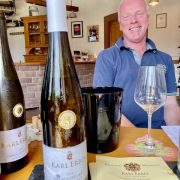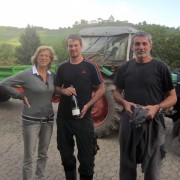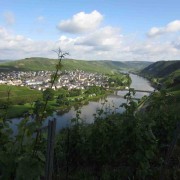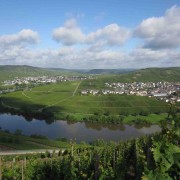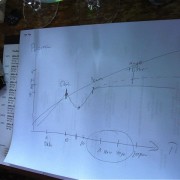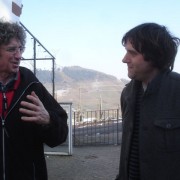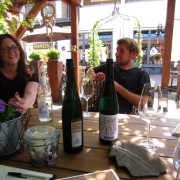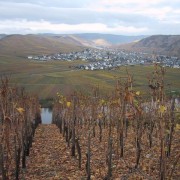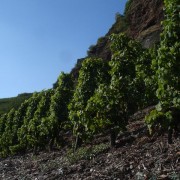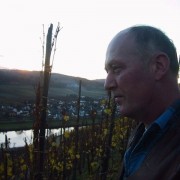Mosel
Clemens Busch (Punderich) BIODYNAMIC
Clemens Busch looks a bit like Jesus. He certainly has intensity and conviction! He started making wine in the late 1970s and was the first to show that, with meticulous work in the vineyards, 100% organic/biodynamic viticulture and if you pick late enough, you can make amazing dry Riesling on a river best known until the turn of the millenium for its sweeter styles. He and his wife Rita have transformed everyone’s expectations of the Punderich vineyards. Punderich was just another village in the middle Mosel churning out dilute, wishy-washy wines with yields of over 100hl/ha. The Buschs crop at around 40 hl/ha. They own more and more of the Marienburg (Virgin Mary’s Castle) and Nonnengarten (Nun’s Garden), which used to belong to the Cloister. They have renovated Clemens’ grandfather’s old house built in 1663 on the riverfront, but continue to make their wines in the cellars up the hill, away from the water’s edge. On one of our early visits almost a decade and a half ago, we asked Clemens about the distinctive and fascinating nose on his wines, reminiscent of aged Rieslings, and he revealed that, in the search for further layers of complexity, he allows his grapes to oxidise slightly before fermentation. A highly unusual technique back when he started doing it. He also picks insanely late. Often 2 weeks later than everyone else. He is the last of the late pickers.
His elevation to the VDP (Verband Deutscher Pradikats – und Qualitatsweinguter/the official Premier League of German growers) seven years ago brought with it added recognition and status from the Old Guard, but it also means Clemens now has to play the politics game. Tinkering with labels and classification – something that occasionally borders on “fiddling with skis” in our opinion.
It’s easy to forget the bureaucracy as you stand outside Clemens and Rita’s 17th Century picturebook house on the riverside, looking up at the overwhelming wall of vines on the opposite bank. Truly one of the most stunning views in a beautiful river valley.
There is nothing of your average Mosel about these wines. They show definition, poise and intensity and set a benchmark of quality for others to aspire to.
Walter (Briedel)
Those of us with functioning memories may remember our German intern Gerrit Walter, who was with us for ten weeks over the summer of 2009 and went back home to help with the harvest before heading back to Geisenheim, the top wine college in the country. He makes an excellent basic Riesling trocken from vines in his home village of Briedel, which has become something of a Winery hit. “Edition G”, his top-of-the-range bottling from the Pundericher Marienberg vineyard. Late picked and packed with minerals drawn from the perilously steep, slate vineyards of the small village of Punderich. One sip and it’s easy to understand why his Dad is giving him free rein in the family cellar. Boy done well!
Lubentiushof – Andreas Barth (Niederfell)
Andreas Barth studied Law and Music but decided, with the support of his interior designer wife, Susanne, to turn to wine-making. He is almost entirely self-taught except for a couple of modules at the famous wine school at Geisenheim. In 1994 they bought an estate on the outskirts of Koblenz on the not very well-known Lower Mosel called Lubentiushof. Sounds grander than it was… But with a run-down cellar came 2.5ha in Gondorf, which is what Andreas was most interested in. It was tricky starting with no customers – but the first two years went well. Then with all the radical work he was doing in the vineyards there were two years when the vines went into shock yielding just 15hl/ha! Now, having recultivated vines that had gone to seed, he has 5ha – many between 35-85 years old. He only uses natural yeasts, and is virtually organic.
Daniel Deckers, a journalist on the Frankfurter Allgemeine Paper encouraged him to go for the vacant Kellermeister position at the large, historic Von Othegraven estate in the Saar. He now works there one day a week, keen to fill the vacuum there and polish the slightly jaded reputation. It’s exciting to work with historic vineyards like Kanzemer Altenberg. “In the Saar there is a homogenous geology within each vineyard. There is often a slight sparkle within the blue slate which means there is a high oil content. Whereas here on the Lower Mosel in Gondorfer Gans there is some blue slate too, but here it is mixed with red and yellow sandstone/slate and quartz. It’s as if someone has taken all the minerals and shaken them up! To give you an example of the effect: if you can expect 24g of mineral extract on the Middle Mosel, you find 27g on the Lower Mosel.” With the low yields and very late harvest in the vineyard, the high extract of diverse minerals and finally a very, very long fermentation, these wines are surprisingly less floral when young, much tighter and more restrained but packed with information and explosive potential! We tasted from three vintages and the oldest, the 2001s, were definitely showing signs of brilliance. His late release 2003s after extended lees contact and the best part of a year in bottle now taste amazing. Fascinating, deep textures and fabulous length.
Scholtes (Detzem)
Michael Scholtes’ dry Rieslings were the standout discovery for us at a Generation Riesling tasting in Berlin in April 2019. Vibrant and fizzing with slatey minerality, a visit was a priority on our next trip to the Mosel. Based in Detzem, west along the river from Trittenheim, Leiwen and Klusserath, this is a relatively undiscovered section of the river – not least because Detzem is in a cul-de-sac with no through road.
After leaving school, Michael studied technical viniculture in Bad Kreuznach before starting in his family’s winery in 2014. The family had 11 hectares, with 4 on the steep slate slopes.
His “entry-level” dry Riesling with barely 2.5 gms of residual sugar comes from vines in the Wurzgarten (Spice Garden) vineyard on sandy, pebbly soil.
If you like the “basic”, you can also try “vom steilen Berg” (from the steep hill) and Policher Held (Polich Hero), which is seriously intense and fleshy.
We visited again in summer 2020. Michael was keen to show us some new parcels they have acquired. More in the heroic Policher Held. Then a bonkers-steep parcel on the Thornicher Ritsch. Virtually impossible to get hold of but somehow they did. “Are you mad?” said Rainer, his Dad, when Michael told him he wanted these vines on the Ritsch. Having declared that it was too crazy and he would never help, Dad seems to have come around, helping Michael reclaim and replant, to the point where now he can be seen proudly showing off the parcel to his mates.
Wegeler (Bernkastel-Kues)
Those of us with long memories may remember Deinhard, a big player in German wines internationally from the 60s and 70s. At that time Deinhard was owned by two families, Wegeler and Deinhard. In the early 90s Wegeler bought the other out. We were delighted to be courted by them recently. “But you are so big and we are so small” – that didn’t bother them. So we thought we’d drop in on their Mosel estate in Bernkastel. Turned out to be a revelation. Famous for their classic fruity Mosels we were delighted to discover that Norbert Breit their Cellar Master also makes elegant, dry wines in his trademark crystal clear, lean style. Wehlener Sonnenuhr Spatlese trocken, yes please! And as for the Bernkasteler Doctor….Lordy! So subtle, so refined. Not remotely showy. It works in much the same way as the finest Burgundy does – it doesn’t kick down the door but creeps up on you.
We simply had to ask Norbert to show us the Doctor, a 3 hectare vineyard on a steep slope above Bernkastel. It wasn’t always 3 ha. Before the 1971 wine law, it was 1.35 ha and was Germany’s most famous and expensive wine. Wegeler owns half of the original parcel.
The story of the name is worth telling. Boemund II was the Archbishop of Trier in the 14th century and was very, very ill. Doctors tried everything. Finally a winegrower from Bernkastel brought some wine from his vineyard and the Archbishop made a miraculous recovery. “That’s the only real Doctor,” he said.
Reuscher-Haart (Piesport)
It was a bottle at Die Mosel, the super wine bar in Traben-Trarbach that brought us to Reuscher-Haart in Piesport. Mario Schwang is the latest generation and can trace his history back through 1919, when his great grandmother (a Haart – one of many in the village) married his great grandfather (a Reuscher) and further, all the way back to 1337! Today’s wines are dry & spicy, an electrifying helter-skelter Riesling ride from Piesport’s legendary vineyards including Domherr – the heart of Goldtröpfchen.
The Piesporter Falkenberg (Falcon Hill) Riesling Kabinett trocken is the epitome of Mosel Riesling: wet slate, purity, elegance, open and expressive.
Harald Steffens-Kess (Reil) ORGANIC
“I want to make a wine that, when you finish one bottle, you want to open another. And another”.
Harald Steffens makes his wines in a leaner, nervier, lighter style with all the whiff of slate that we love from the Mosel.
He has been organic for decades. “I’m the one who went round to Thorsten Melsheimer and signed him up to Ecovin” says Eco vintner Harald Steffens-Kess. Harald Steffens-Kess is friend and almost neighbour of Thorsten in the village of Reil on the Mosel. He has a small parcel in Reil, the rest on the opposite bank in generally more sun-favoured Burg. His Hahnenschrittchen (hens’ little steps) is the best we’ve tasted from that vineyard.
One time we visited Harald at the end of February and the then recent high water was a topic along the valley. “It was high this year, but not as high as 1993 when I put my boat in the cellar and gave rides to my kids and their friends. I was in waders in the freezing water. Brrrr. They still talk about it!”
It has taken us a long time to realise that Harald Steffens makes Sekt. We had been buying his slender, feather-light dry Rieslings for the best part of a decade before we spotted it on his list when we visited recently. “You make Sekt?” “Yes. Have done for ages.” Ah.
We found his Sekt delightful, with a proper Mosel Riesling nose, lovely weight and balance.
Andrzej Greszta (Krov)
Andrzej Greszta came from his home town of Lublin in southeast Poland to Germany in 1996 to help with a harvest. He was 26 and never moved back. He makes the 1,500km journey twice a year, once to pick up his family and friends to help with his harvest. He was an apprentice at Daniel Vollenweider’s and then worked at Staffelter Hof and still does two days a week at Immich-Batterieberg. He did a three year course on Vines and Winemaking and made his first wine in 2006. He was half thinking of heading to Australia, but his course professor was so complimentary about his first wine that he felt encouraged to stay. He has now accumulated two hectares of vines in Krov – in Steffensberg, Letterlay and Paradies. His wines are pure and crystal clear. Very Mosel. Clear expressions of each vintage.
Martin Mullen (Traben-Trarbach)
Quietly determined Martin Mullen had a falling-out of almost biblical proportions with his father, ending up with Martin going his own way and effectively building up his vineyard holdings from scratch. We have been watching his wines for a while. Shallow as it may sound, we were originally put off by the kitsch bird motif on one of his labels. But then the wines haunted us… Beautiful, poised, focused wines of finesse and polish.
Krov may have been built on the bawdy image of the Krover “Nacktarsch” (naked bottom), but Martin is almost single-handedly raising the reputation of its finest slopes “Paradies” and “Letterlay” with his hauntingly fragrant, pure wines.
Bastgen (Kesten) ORGANIC
A German love story. Armin Vogel met Mona Bastgen at Geisenheim, the world famous wine making academy, and once married, they began to pursue their dream of making wine themselves. Taking over from Mona’s butcher and vintner father in 1992, the couple live and work in a hi-tech wood and glass house atop a hill with stunning views towards Bernkastel. Armin spoke to us of wanting to make “slender” wine, capturing the balance of fruit and minerality which typifies the best of the Mosel. He’s bored of the succession of hot ripe vintages preferring the racy balance of the rainy grey ones!
The wines have great tension, with a certain “nervy” balance to them, notes of white flowers, pears, and a friendly crowd-pleasing quality which caresses those new to German wine, rather than slapping them about the face.
Karl Erbes (Urzig)
Urziger Wurzgarten (spice garden) is a striking vineyard in the middle Mosel. It has a Hollywood-style sign high in the vines and is probably the largest concentration of red slate in the Mosel. It owes its red colour to the iron oxide suspended in the slate which gives Riesling an exotic, flamboyant overtone. We have often stayed in Urzig and have dabbled in its spicy wines. We happened to be in the Mosel valley one weekend in June when the annual Mythos Mosel tastings were on. There were people we needed to see. High point of the day was the only dry wine on Karl Erbes’ table: Urziger In der Kranklei Riesling Spatlese* trocken 2022. Exotic, herbal, viscous. So we picked up a parcel when we were back there a couple of weeks later. Stefan Erbes, who runs the estate, has a bunch of older Rieslings for us to taste when we next visit. Stefan reminded us that our mutual friend Knut Aufermann would often help in the tasting room. Knut is an experimental electronic musician who, with his girlfriend Sarah Washington (also in electronic music), was a key anti Mosel bridge protester when it was a hot issue around 2008-2012. Unfortunately the unnecessary and under-used bridge was built. But that is another story.
The vineyard has vines up to 80 years old and sits precariously above the sundial close to Erdener Pralat. The name is intriguing. “Krank” usually means “sick” or “ill” in German and “Lei” (same as Lay or Ley) is derived from the Celtic, meaning “slate” or “slate rock”. Apparently “krank” has nothing to do with “sick” in this case but is a purely phonetic development from “grande” (often pronounced grang in German) to “krank”. Shame. We quite liked the idea of “sick slate” in the contemporary application of “sick”. That’s some sick Riesling. Anyone?
Julius Treis (Reil)
Gewurztraminer? Sometimes nothing else will do. It has been increasingly difficult to find a dry Gewurztraminer over the last two decades of global warming. In the summer of ’22 we found a beautiful, balanced, dry one in Reil on the Mosel – of all places! Tobias Treis can trace his family’s wine-making history back to 1684. With just 5 hectares, 90% in the steep slate slopes overlooking the river Mosel, clearly Riesling is the main theme. A friendship formed almost 20 years ago has influenced the direction.
Tobias Treis met Ivan Giovanett at Geisenheim – Germany’s leading Wine University. Ivan’s family winery is Castelfeder in the South Tyrol. You can sense the high altitude middle-European influence in Tobias’ non-Riesling whites.
Tobias and Ivan have collaborated to revive the Sorentberg, an ancient Riesling vineyard in a well-ventilated side valley above Reil, abandoned and completely overgrown for 25 years. It was intense, backbreaking work clearing the area and reviving the vineyard vine by vine. The Sorentberg has a unique geology – Wissenbach slate – red slate with Muschelkalk (chalk with fossils).
Studert-Prum (Wehlen)
Wehlen is one of the most famous wine villages on the planet. Its vineyards cling to the slope on the opposite bank of the Mosel, a slope of uninterrupted Grand Cru sites from Bernkastel through Graach and Wehlen up to Zeltingen, where the river starts another loop. Wehlen is best known for its Sonnenuhr (Sundial) vineyard. It is also inextricably linked with the family name of Prum. This is where it gets complicated. There are several Prums in the village; JJ Prum (by far the most famous and still making exclusively sweet styles), SA Prum, Weins-Prum and Studert-Prum. Other well-known estates such as Dr Loosen, Robert Weil, Christoffel and Pauly-Bergweiler also had Prums in their families.
Gerd & Stephan Studert’s mother is one of the SA Prums and the SA Prum estate was divided between her (which became Studert-Prum) and her sister (who retained the SA Prum name).
Gerd, his brother Stephan and nephew Michael had five hectares of vines, which may not seem much, but the fact remains that they are all in great vineyards in Wehlen, Graach and Bernkastel. Gerd retired in 2014 and sold his vines. Stephan and his son Michael moved the cellar back into the original family home on the river front. Stephan has since supposedly retired and Michael has taken over. The generational shift has happened.
While it was a bottle of Wehlener Sonnenuhr Riesling Spatlese trocken 2009 which we drank at the Moselschild in Urzig almost ten years ago that brought us knocking, we have enjoyed their classic Mosel Rieslings ever since.
Simonis (Punderich)
Punderich may be one of the most beautiful villages on the incredibly beautiful river Mosel but, in wine terms, until the rise of Clemens and Rita Busch in the 1980s and 90s, was widely thought of as average, at best. Today its reputation is dominated by Clemens and Rita – they have set the bar extremely high.
Things are changing and a new generation is coming up. Gerrit Walter, our friend and ex-intern who lives in the neighbouring village of Briedel, also has vines in the Pundericher Marienburg and has been making exciting wine for his Edition G Marienburg bottling.
We found ourselves at something suspiciously like the Punderich Village Summer Fete last July. It was an all-day event, culminating in an evening of Flammkuchen (a super-thin pizza with onion, cheese and lardons) and dancing (Hoedown followed by Oompah and Techno). The main theme was the “Riesling Kartell”, a group of six young growers from the village. One was Johannes Busch, son of Clemens and Rita, who is working alongside Clemens in the cellar. No prizes for guessing how good the wines were!
It was around this time that some other visitors arrived; Kilian Franzen from Bremm, who was about to become a father a few days later; Gerrit Walter and his girlfriend Julia. As we were piling through our second bottle of Busch’s Marienburg GG, we asked Gerrit if there was something we should be trying. “Try this” he said, passing a glass of Kabinett trocken. It was proper Mosel – light, delicate, floral and yet with backbone – all about herbs and salty, slate minerals and racy, running water. Lovely. What is it? It’s Nico Simonis’ Rotschiefer Kabinett trocken 2014. He’s young and learning a lot, working a few days a week at Franzen.
Needless to say, we visited Nico and his parents Elke and Elmar soon afterwards. It’s a very small winery with just 3 hectares of vines.
Nico (25 when we visited first) did his practical vineyard studies at Bad Kreuznach in the Nahe an internship at the Buschs’ and now splits his time between his family’s winery and Franzen.
He is very proud of his Rotschiefer Kabinett trocken, the wine that brought us to his door, because it was the first wine that his father let him do entirely his own way. It turns out that his father, Elmar, was very nervous about Nico’s wine. Nico was using wild yeasts and long lees contact, like he’d seen at Franzen’s. By contrast, his Dad was taught a very different style of winemaking – super clean, super safe, zero risk. The results in the bottle and the reception locally suggest that Elmar may let Nico do more going forward – or at least try to look the other way!
Eva Clusserath (Trittenheim)
What a coincidence, our mate Stuart Pigott, the German Wine Journalist based in Berlin was on the Mosel at the same time. So we gate-crashed his meeting with Eva Clusserath (and her boyfriend, now husband, well-known winemaker Philipp Wittmann from Rheinhessen) in Trittenheim. There seem to be thousands of Clusserath’s in Trittenheim! Eva has been making great leaps since she took over from her father Ansgar in 2001. Of course, her Trittenheimer Apotheke Spatlese trocken, made from 60-70 yo vines was bound to be fabulous in 2005. What really impressed us was the quality of the entry-level wines, Vom Schiefer (from slate) and Steinreich (stone-rich or stone-empire).
Deutschherrenhof (Trier-Olewig)
Trier is a city thick with history back to Roman times and has long been a centre for the wine trade on the Mosel. The village of Olewig is barely 5 minutes’ drive from the centre of Trier. It is wonderfully fitting to see vineyards on the hills overlooking the city. After the obligatory stint at Geisenheim (Wine Uni) and internships in Australia, New Zealand and around Germany, Sebastian Oberbillig (now 34) is the driving force in his family’s winery. The winery has been in the family for five generations. His father, Albert (who still works in the winery, mainly on admin, bottling and labelling), had 3.5 hectares of vines. Sebastian has grown their holdings to 11.5 hectares in Deutschherrenberg, Burgberg, Jesuitwingert and Deutschherrenkopfchen.
Deutschherrenkopfchen, previously known as Olewiger Vollmuhle, was once held to be one of Trier’s finest vineyards with its steep south/southwest exposure on Devon Slate, but for decades people thought it had become impossible to work. Sebastian got hold of the vineyard in 2007, cleared it, revived the soil with 180 tonnes of compost and 1,000 bales of straw, before replanting with a variety of old Riesling selections. He is excited by the potential of the site – as indeed are we.
Thorsten Melsheimer (Reil) ORGANIC
“I’m the only one stupid enough to work the crazily steep vines in Reil” says Thorsten Melsheimer, the perfect picture of a Saxon in rude health. “It’s not as if the vines are actually facing in an ideal direction either. It forces you to work hard. It helps to be biodynamic. You have to slash the yield and pick insanely late. I bought some vines in a perfect south facing vineyard on the other side of the river and the wines are not as interesting – the vines are just lazy!”
Thorsten is certainly not lazy – certified Ecovin (Organic) since 1997, he has been nursing old vines back to life, rebuilding walls in the remotest, steepest, least accessible parts of the Mullay-Hofberg vineyard. “When I get really hot working in the vines, I jump into the Mosel for a quick swim to cool off.”
Thorsten has several bottlings based on old vineyard parcel names. Langeberg, Schaf, Pfefferberg and Molun, a wine that he describes as “liquid history”. Molun was first mentioned in 1143, in a document witnessed by King Conrad III, when it was bequeathed by a Palatinate Graf. Molun was a farm in a slightly sheltered corner, a break in the long uninterrupted slate slope just south of Reil. Molun would morph into Moley, then Mullay, and become the name of the pre-eminent vineyard of Reil – the Mullay-Hofberg. Thorsten has revived the vineyard and the name.
His wines have all the nervy definition and slatey minerality we have come to expect of the Mosel’s finest.
Stein (Alf)
We first spotted Stein’s Domwein (Cathedral wine) at the excellent and very friendly Restaurant Zum Eichamt in Zell-Merl. On our next visit we called Dr Ulrich Stein and made our way up to his amazing house at the top of the hill above the village of Alf. It was dark, rainy and hard to find. Vines mark the beginning of the steep drop. Even on the darkest winter evening the view downstream is breathtaking. Ulrich’s signature technique is to blend two tanks, one a very racy early-picking with another, much richer late-picking. He says that gives each wine the best of both worlds, the nervy higher acidity with as sense of depth and ripeness.
Franzen (Bremm)
The Franzens are gradually adjusting to life after Uli, the 54 year-old father, died in a freak vineyard accident in June 2010. Uli lived his entire life in Bremm on the Mosel, a village he put on the map with his mineral-laden dry Rieslings. We always enjoyed our visits with Uli. Sometimes he would take us in (although clinging to would be more apt) his vertical monorack rail, up the Bremmer Calmont, the steepest vineyard in Europe – steeper even than Hermitage, Cote Rotie and Priorat. From there you can see the Neefer Frauenberg, just beyond the ruined convent that Turner painted when he did his tour of the Mosel.
Everyone rallied round after the accident. Uli’s brothers helped with the bottling, the kids were all-hands-on-deck, friends and fellow growers were also near. His young son Kilian, in his last year at wine college, stepped up to the plate.
Kilian and his girlfriend (now wife) Angelina Lenz are now fully established, making modern dry Riesling, picked very late (at the end of October) for full ripeness and quivering with smoky minerals from the quartz-infused slate.
There is a new bottling in their line-up, complete with a new label, “Der Sommer war sehr Gross” (the summer was great), a quote from Rilke, the German Poet.
The latest addition to their line-up is a baby daughter, Emilia, in August 2015.
Haart (Piesport)
When we emerged from our tasting at Clusserath-Weiler ten or eleven years ago, there was a message on the voicemail. “Stuart here. (That’s our Berlin-based wine writer friend Stuart Pigott). I’m round at Theo Haart’s. The wines are…. frankly stunning (paraphrasing for the faint-of-heart). He’s not working in the UK at the moment. You’d better get your asses over here.” So we jumped into the van and charged over to Piesport to catch them before they left the restaurant. Theo is world-renowned for his classic sweeter Piesporters and, yes, the 2005s were sumptuous. Wild yeasts, classic blackcurrant leaf aromas, ripe peachy yellow fruit mouthfeel, with smoky, slatey minerality and exhilarating acidity – high-class fruity Mosel which can age effortlessly for 30 years or more. We have been frequent visitors since then.
Piesport is one of the most famous villages in the Mosel valley. The Haart winery is, without doubt, the top estate in Piesport and can trace its history back to 1337. The family has beautifully kept old parcels in prime vineyards in Piesport and Wintrich, all on steep slate slopes teetering precariously over the river.
Johannes Haart’s father Theo is a master (and lover) of the sweeter styles of Mosel Riesling. While Theo has been in the decade-long process of retiring, Johannes has overseen a steady increase in their dry styles. Recently his younger, hipster brother Marcus has joined the team.
From dry Piesporter and Wintricher, to the Goldtropfchen and Ohligsberger GGs and then over to the sweeter Kabinetts, Spatlese and Auslese – the entire range is impeccable.
Andreas Schmitges (Erden)
From the steep, iron-rich red slopes of Erdener Treppchen and the even steeper Pralat come Andreas Schmitges’ gently spicy, boldly perfumed, beautifully judged modern dry Rieslings. He knows they’re good. Why fight it?
Kirsten (Klusserath) ORGANIC
Bernhard Kirsten is from the Mosel; Inge from Hamburg. They met in 1987 in New York while she was working in the travel business and he was passing through, visiting his sister, between Germany and California where he had internships at Domaine Napa, Pine Ridge and Mondavi in Oakville. After a couple of years learning about Cabernet Sauvignon, he came home to take over the family winery and concentrate on Riesling. Wind forward 26 years and the winery has grown to 15 hectares and, for the past 5 years, is fully organic. Well-known domestically for their sekt and locally for their trester (marc/grappa), the core of their output is dry Riesling. Although they have a little bit of Kowericher Laurentiuslay and Policher Held, most of their vines are in the magnificent, sweeping loop of Klusserather Bruderschaft, many in the Herzstuck (the heart piece) – the best part. The wines are impressive, packed with surging minerals, deep, textured and multi-layered.
Altmann (Neef)
We were picking up from Schloss Schonborn in the Rheingau and, once we had loaded, the woman in the Despatch department said, “I make wine on the Mosel. Would you like to try it?” Sure. And we took two bottles with us. Fascinating labels – very clean and arty. Most fascinating was the GPS location of the exact parcel of vines. Nice touch. A new spin on terroir, refined for Googlemaps and TomTom.
On one of our next visits we phoned Hedda Nuetzmann. She was surprised to hear from us. Yes, we liked the wines, particularly Steiler Suden (steep south). Can we meet at Zum Krug, taste the whole range?
Hedda has several jobs. In Despatch at Schloss Schonborn, as a masseuse and, with her boyfriend, a well-known German theatre actor, now retired, called Michael Altmann, produces a meagre number of bottles from a few rows in Neefer Frauenberg…on the Mosel. Intriguing. They make four bottlings from less than a hectare. Steiler Suden (steep south), Rosengartchen (little rose garden), Der Schoss (the lap – a Y shaped parcel in the vineyard) and Der Rote (the red one). Confusingly the red one is actually rose made from young vine Spatburgunder and Dornfelder. The others are all Riesling, all very pure and unmessed-with. Steiler Suden often has a wild yeasty nose, Rosengartchen is daintier.
News – Hedda and Michael have recently married. Hedda stopped at Schloss Schonborn and worked for a while at Chat Sauvage. Our colleague Dan Towler did the 2011 harvest with them and Rosengartchen 2011 is now on our shelves (probably briefly).
Clusserath-Weiler (Trittenheim)
It’s difficult to imagine a more idyllic way to start the day, breakfasting in the house on Trittenheim bridge with the Apotheke vineyard towering above you on the opposite bank and watching the sun swing over the hill, gradually bringing the vines into the light as the mist rises over the Mosel. Father and daughter, Helmut and Verana, do the wine, mother Helga runs the guesthouse. Trittenheim is full of Clusseraths so to avoid confusion Helga brings the Weiler name with her from nearby Mehring. They always use wild yeasts, which can give their wines a wild perfume. The “HC” is crisp and lean, with spicy minerality. The Alte Reben (Old Vines) comes from a parcel of 50-75 yo vines and gives a deeper, denser flavour and mouthfeel. The “S” is a selection of the best bits of the best parcels, (usually from a small beautifully placed triangular parcel half-way up the vineyard immediately opposite the house) – while not the oldest vines hre are none less than 30yo. Virana was excited by the 2005s. After a slightly disappointing cool summer there was a long warm autumn giving the grapes the same ripeness and supercharged alcohol as the 2003s but with much better acidities.
Martin Conrad (Brauneberg)
Martin Conrad is a twenty-something young buck from the beautiful, loopy Middle Mosel. Martin took over from his parents a few years ago and is hell-bent on raising quality. His mother runs the family’s hotel and restaurant in the village of Brauneberg while Martin concentrates in his winery on the opposite side of the road. His style is modern, dry Mosel Riesling with more-ish minerality. Ripe in the nose (from the late-harvested grapes), succulent in the mouth and dry on the end.
Immich-Batterieberg (Enkirch)
We have been circling Immich-Batterieberg for some years and have swooped. Strictly speaking it has been re-circling and re-swooping. We bought a couple of times almost a decade ago from the previous owner, lawyer Gerd Bastgen, and have just started again with the new incumbent Gernot Kollmann.
Immich-Batterieberg is a historic estate and has some of the best vineyards in Enkirch, including the monopole Batterieberg. It can trace its history as a winery back to 1425. One of its buildings has a longer history, dating back to 908 AD. The East Frankish (Carolingian) King Ludwig IV had a throne room here and bequeathed the building to the Church.
The estate was in in the hands of the Immich family from 1425 until 1989. The intriguing Jugendstil/Belle Epoque style label with the two cherubs firing a cannon at the vineyard tells the story from 1841 of the incumbent Immich wanting to modify the exposition of his vineyard and tilt it more in favour of the sun. He achieved this by pounding the steep slope with cannons (some say it was dynamite) – the deafening sound ricocheted along the valley.
Winding forward to recent times. Star winemaker, Gernot Kollmann, had tried to buy the estate from Gerd Bastgen with various sets of backers since tongues began wagging that Immich-Batterieberg may be up for sale. Bastgen went bankrupt in 2007. Recession arrived in 2008 and finally, in 2009, Gernot managed, with the help of two wine-loving backers from north Germany, to buy the estate from the bank.
Gernot Kollmann is widely known and respected. Now 46, he comes from the Ruhr, southeast of Dortmund – an area that has nothing to do with wine. Although he studied at Heilbronn, he says he learnt everything he knows while working. He did two years at Dr Loosen, three years at the Bischofliche Weinguter in Trier, then worked for four years at van Volxem when the Bitburger heir Roman Niewodniczanski bought the estate. From 2004 until 2009, Gernot worked as consultant at Knebel in Winningen/Mosel, and at estates on the Ahr and in Bulgaria.
Gernot is running a lean operation at Immich-Batterieberg. With 5.5 hectares on the very steep slate slopes around Enkirch, he does all the work himself with one full-time co-worker and the occasional apprentice! He had a fascinating statistic for us when we visited recently. A top winery in Rheinhessen reckons it takes 450 hours each year to work each hectare. An average Mosel winery with a balance of steep and flatter vineyards (where a tractor can be used) needs 700-800 hours per hectare. Gernot worked out recently that for them, with nothing but steep-sloped vineyards, they need 1,007 hours per hectare. That’s a ton of work. But the results are worth it. Definitely.
“There is one other thing I can show you,” said Gernot, after an excellent tasting of his deep, fleshy Rieslings. “It’s an oddity, a new wine – I only make three barrels.” What is it? It was a pure, gently autumnal Spatburgunder from the full south-facing Monteneubel vineyard, just to the north of Enkirch. Monteneubel? Morphed from the French, Mont Noble or Noble Hill.
Knebel (Winningen)
From the dizzyingly steep Terrassenmosel (Mosel Terraces), where the Mosel tips into the Rhine at Koblenz. Knebels have been growing vines here since 1650. Beate and her son Mathias’ vineyards are vertigo-inducing, yields are extremely low and the grapes are painstakingly picked by hand. Wild yeasts often give their wines striking aromas. The Mosel is all about minerals, slate and racy precision. Intense and packed with savoury minerals, they are almost like licking slate.
Rebenhof – Johannes Schmitz (Urzig)
Johannes Schmitz is an energetic player in the well-known village of Urzig. He and his wife run a guest house from their winery. He is the President of the committee that has been arranging the “Flurbereinigung” (the re-structuring and rationalisation of the German vineyards, a process that started in 1968) – a sure way to win some friends and lose others! He has 4.5ha, one third of which are young vines, the rest are between 40 and 80 years-old. His “Alten Reben” is always from his 80 y.o. vines. He sets a benchmark for Urzig, with all the body and herbal spiciness the Wurzgarten is renowned for.
Rudolf Trossen (Kinheim-Kindel) BIODYNAMIC
“Fate” Rudolf called it, when we called by on the off-chance and found him in. This after phoning for directions from the riverside car park. “Can you see the house with the round windows on the opposite bank of the river? That’s me waving!”
We were intrigued by whispers of a very uncompromising grower in Kinheim-Kindel. Rudolf Trossen, leather waistcoat, Scholl footwear, is a Hardcore Eco-warrior…and poet. His father came back from the Russian front after the war with half a leg missing, so Rudi had to do all the spraying and had an allergic reaction to the chemicals. Having not been convinced he was going to take over from his father his allergies got him thinking about ecology. He had found his cause. “Biodynamics started here in Germany with Rudolf Steiner’s theories from the 1920s” he says. He founded Demeter and Ecovin in Rheinland-Pfalz.
His vines all lie in the Kinheimer Hubertuslay and, as he points to his parcels scattered on the opposite slope, it quickly becomes clear which are his – the ones with green ground cover. So what are the wines like? The Schieferblume (Slate Flowers) and Trossen Kabinett trocken are lively, fresh – and savoury, smoky, with loads of mineral content. The Madonna Plateau is from a parcel of pre-phylloxera vines above a small statue of the Madonna. Wonderful, crazy-subtle perfume and fabulous density.
Saar
Peter Lauer (Ayl)
“Come and look at the Schonfels!” said Florian-Peter Lauer. We were on the Saar at his parents’ Hotel, the Ayler Kupp, tasting through his sizzling range, which were beautifully balanced on the knife-edge between dizzy savoury fruit and searing Saar acidity. The view was gorgeous. He recently bought the parcel from an old boy in the village. “There was a lot of work to do, but look how old the vines are, look at the slate, look how steep the slope is. Don’t go too close to the edge, there’s a big drop down the cliff to the Saar!”
Florian has been showered with awards in Germany in recently. He works the family vines in top vineyard “Ayler Kupp”, one of the most hallowed vineyards on the Saar. Florian took over full responsibility for the wines recently, leaving dad Peter to focus on the hotel they own south of Trier, with a splendid view of the river – although, when the fog rolls in though, it’s difficult to see much of anything.
Loch – Weinhof Herrenberg (Schoden) ORGANIC
Manfred and Claudia Loch bought their first half-hectare plot in the Schodener Herrenberg vineyard in 1991. Each year they try to buy another 0.2ha and another steel tank. They currently have 2.5 hectares and 8 tanks. The steep Herrenberg is an almost fan-shaped slope overlooking the Saar and the village of Schoden 3kms north of Saarburg. Yields in the area are often over 100hl/ha, but the Lochs are working between 20-35hl/ha. You can taste the difference! The Saar is known for producing wines of racy acidity, hard to taste young, tightly-wound and softening only with age.
The Loch style is something else: much riper, much fleshier than your everyday shrill Saar wine. They still have a refreshing, exhilarating acidity, but with richness, depth and a unique mouthfeel. They leave the grapes on the vines incredibly late hoping to squeeze another degree Oechsle (ripeness level) or two out of the late autumn sun.
Their plots are dotted over the vineyard. Each parcel is picked separately, placed in separate tanks and bottled separately without fining and only one very light filtration. The Lochs (and we) are fascinated by the differences – each is clearly distinct.
New this time is the Wiltinger Schlangengraben old vines trocken, from a parcel (unlike most from that vineyard) overlooking the Saar. Also we had to wrestle Manfred for a few bottles of the Ockfener Bockstein trocken – he would dearly love to get hold of more vines in Bockstein – but there are three large land-owners who hold most of it and unfortunately don’t want to sell – shame, in Manfred’s hands the wine achieves another level of spicy intensity.
Also a new label – the third in as many years…a gentle identity shift. First there was Weinhof Herrenberg, then there was equal billing for Weinhof Herrenberg and Loch, now it’s simply Loch.
Von Othegraven (Kanzem)
Terroir. It’s a sense of place. It’s the expression of the earth, of the geology. Here on the Saar, like the Mosel that it feeds, it’s all about slate. The slate here sparkles with Quartz, which often gives the wine a dizzy, spicy, almost tropical character.
History is also a sense of place. The magical von Othegraven estate can trace its roots back to the 1500s.
We always loved Dr Heidi Kegel, the charming former head anaesthetist from Cologne hospital, who was left the historic von Othegraven estate by a maiden aunt in the early 1990s. When we phoned she would say “what time would you like to come?” “How’s 11.00h? “Would you like to stay for lunch?” We have many memories of lunch with her, her geologist husband and our friend Andreas Barth, her winemaker (whose Lubentiushof wines we also adore). There would always be a moment when she would say, Andreas, can you bring up something old from the cellar?
Unfortunately Dr Heidi became ill and in 2009 decided it was probably time to sell. Enter Gunther Jauch, generally held to be the most popular man in Germany. An unassuming man, he’s a TV host and commentator, a national treasure, a kind of David Attenborough figure (without the nature programmes). Gunther is a distant relative of earlier owners and brought a new energy to his new acquisition. The same team of Andreas Barth and Swen Klinger remained in place and continued to make exquisite wines, a world away from the searing acidity of the old-school Saar wines. Effortless.
No nonsense Swen Klinger, from southern Germany, joined von Othegraven in 2004 at the same time as Andreas. Originally hired as vineyard manager and cellarmaster, he has also taken on the wine-making role. Prizes and gongs abound.
The estate only has Grand Cru vineyards on the Saar. Kanzemer Altenberg (the magnificent steep slope behind the von Othegraven house), Wiltinger Kupp, Wawerner Herrenberg and the super-spicy Ockfener Bockstein.
Ruwer
Van Elkan (Mertesdorf)
We have frequently searched along the Ruwer, the small tributary that joins the Mosel just east of Trier, where the wines have remarkable delicacy and race. A tip from Marco Winterberg, a teacher and part-time wine importer in Holland brought us to Marco van Elkan’s door. He works full-time in a social research project at Trier University, so our appointment had to be early. Very early – we were tasting dry Riesling at a bracing 8.30h in the morning.
He bought a miniscule parcel of abandoned vines in the Kaseler Nies’chen vineyard in 2001 and nursed the 70 year-old vines back to life. First vintage was 2003. The vines were grateful and, with some guidance from Peter Geiben (of Karlsmuhle) and Ludwig Breiling (former wine-maker at Karthauserhof), the results are pure Ruwer. Clear, herbal and fresh, like a fast-running mountain stream.
In 2008, he and his wife built a striking new house that includes holiday apartments and his cellar. Marco now has four parcels of vines totalling half a hectare (still tiny) which produce a meagre 3,000-4,000 bottles a year. We bought 4% of his 2011 production!
Rinke (Mertesdorf) ORGANIC
Die Mosel, the super wine bar in Traben-Trarbach has provided fertile hunting ground for new growers. A stand-out red on a visit in June 2023 was from Rinke. Marion Rinke works as a lawyer in Luxembourg, lives in Trier with her husband Alex, who works in catering in Trier and who now makes the wine. Their cellar is in Oberemmel in the Saar and their tasting room is in Mertesdorf on the Ruwer (right next to the river). It’s hard to keep up.
Their story seems familiar: a couple love wine and decide to buy some vines and make wine. Simple, right? It never is that straightforward but following a steep learning curve they have prevailed. They started in 2006 with Langsurer Bruderberg a steep vineyard in the unfashionable bit of the upper Mosel between Trier and Luxembourg. Its Muschelkalk (chalk with fossils) geology has more in common with northern Burgundy than the slate dominated Mosel.
In 2015 they picked up old vines in steep slate vineyards on the Saar in Oberemmeler Altenberg, Wiltinger Klosterberg and Wiltinger Braunfels.
It was love at first taste with the Fruhburgunder (aka Pinot Noir Precoce or Pinot Madeleine), an early ripening mutation of Pinot Noir. Seems delicate at first then, with air and a little time, the haunting aroma emerges and the Pinot-esque persistence reveals itself. Yum.


